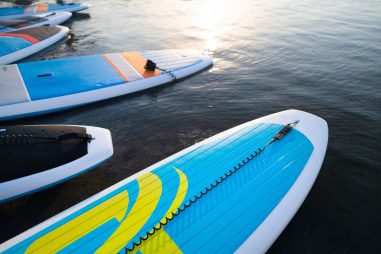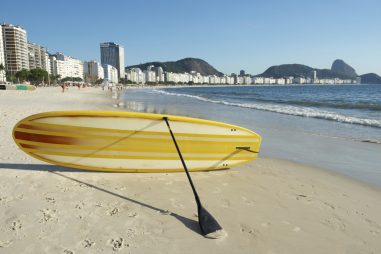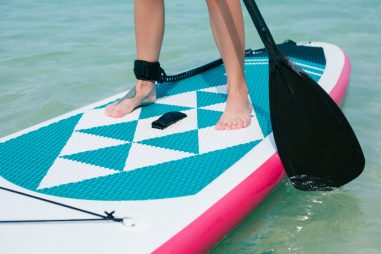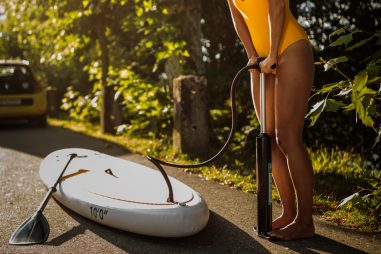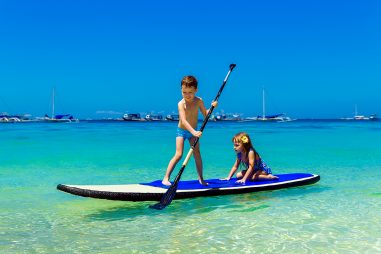Stand up paddle boarding continues to charm people all over the world. Aside from being fun and easy, it has incredible health benefits, helps you keep your focus and your balance, and improves your mental stability. If you are curious to know why people are raving about this sport, what paddle boards are used for, where and when they originated, and the science behind paddle boarding, then read on!
What Is the Point of Paddle Boarding?
The basics of stand up paddle boarding are simple: you get a board that is a bit larger than your regular surfboard, you concentrate on your balance, look ahead, stand upright on the board while paddling through the water, and try your hardest not to fall.
It was meant to be another come-as-you-are, no-fuss sports activity but over the years, stand up paddle boarding has developed into something more than a water sport. It allows you to enjoy the water in a fun way that not only benefits your entire body but is also beneficial to your mind. It improves your posture and concentration while also strengthening your heart and muscles. It’s also a perfect way to meditate and enter a flow state of mind.
What Are Paddle Boards Used for?
There is no shortage of things to do on a paddle board. Sure, it is called a stand up paddle board for a reason, but it has since stopped being just a board for standing up in. Today, stand up paddle boards are used for fishing, racing, touring, lobstering, white water rafting, wake surfing, spearfishing, and even doing yoga!
There are many different types of paddle boards because they cater to various things, uses, riding goals, and riding style. So, even if you buy a stand up paddle board just to dip your toes in the sport, you will soon find out that it is beneficial in so many ways.
Why Is Paddle Boarding So Popular?
Stand up paddle boarding has become one of the most popular water sports in the world, not just because it’s a lot of fun but also because it has a lot of great health benefits. The many reasons why stand up paddle boarding is so popular and well-loved include its ease of learning, safety, and inclusivity.
While stand up paddle boarding has existed since the dawn of time, it was not until the early 2000s that it became such a popular sport. The number of paddlers all over the world increased by millions all of a sudden. Today, it is on its way to being recognized by the Olympic Sports Committee. Once that happens, there will be no question that the world’s ever-growing population of paddlers will continue to expand in the future.
What Is the Appeal of Paddle Boarding?
There are many different reasons why people find stand up paddle boarding very appealing. It is easy to learn, easy to use, easy to transport (especially if you own an inflatable board), and very easy to love. It is enjoyable whether you ride it standing up, sitting down, or lying on your stomach in various bodies of water.
It is a low-maintenance activity with lots of benefits. Aside from that, stand up paddle boarding is very inclusive and can be done by anyone regardless of age, gender, skill level, or fitness level. It is a low-impact sport that works all the muscles in your body and helps you focus, improves your balance, and aids you in reaching a flow state of mind.
Another thing that makes stand up paddle boarding appealing is the way it makes you feel extraordinarily close to nature. It offers a fun, new way to spend time in the water, and it is just an overall relaxing sport (except when you are competing, that is).
Is Paddle Boarding a Sport?
Paddle boarding is, in fact, recognized as a full-pledge professional and competitive sport. Some people become so involved in the sport that they compete, teach, and encourage other people to be professional paddlers themselves.
If you are thinking of going pro, the Professional Stand Up Paddle Association, or PSUPA, is an excellent place to start. It is a sports organization committed to helping paddle boarding instructors and professional paddlers. They also ensure that paddle boarding is being promoted in the safest and most effective way possible.
Where Did Paddle Board Originate?
It is unclear when or where stand up paddle boarding really began. But there have been many historical facts and pieces of evidence that people from different parts of the world have been paddling as early as 3,000 BC. Peruvians, Israelis, Italians, Chinese, and Hawaiians have all enjoyed various iterations of stand up paddle boarding since the ancient times.
The origins of modern stand up paddle boarding, on the other hand, can be traced all the way back to the 18th century on the beaches of Hawaii. With primitive-looking boards primarily made of wood as their vessel, Hawaiians were said to be the first people to paddle across the Pacific, from one island to the next.
Who Invented Paddle Boarding?
Although it is not clear when exactly paddle boarding began, it is said that natives in the Peruvian city of Chan Chan rode the waves as a means of sport and entertainment as far back as 3,000 BC. Caballitos de totora, which translates to “little horses made of reed,” was the name given to Peruvian boards.
The base of Peruvian paddle boards was tightly bound reeds, which are thick, grass-like plants commonly found in swamps and wetlands. A bamboo stick was widely used as a paddle to assist them in their journey.
Stand up paddle boarding has been practiced by Israelis and Arabians since the 8th century AD. They used a hasake, which was represented as a cross between a board and a boat that was more commonly used for fishing. Hasake was designed with a 5-foot width in mind, making it ideal for rescuing surfers, boaters, and swimmers who got themselves into trouble in the ocean.
Gondolas became a mode of transportation in the 1400s in Italy, allowing Italians to travel from one submerged city to another across the water. The gondoliers, as seen today, stand on the deck of the gondolas and steer the boat with an oar as it moves through the sea.
A Waikiki surfer named John Ah Choy is credited with pioneering modern stand up paddle boarding in the 1940s. Ah Choy used to be a young and agile surfer, but as he got older, it became more difficult for him to get up and down his board. This was why he resorted to standing on his board from the break and catching waves with a canoe paddle.
Ah Choy’s sons, Leroy and Bobby, and a friend named Duke Kahanamoku, who were all famous surfing instructors in Hawaii and were known as the Waikiki Beach Boys, continued doing his technique. They were seen standing on their boards as they went around and instructed their students.
When Was the Paddle Board Invented?
Paddle boarding has been around forever, which means that iterations of paddle board have been around for the same period of time. Sure, it may not be the modern paddle board that we have today, but you can’t expect a 3,000-year-old board to be anything but primitive.
The predecessors of today’s paddle board include boards made of grass, a board that looked like a combination of a boat and a paddle board, and really ancient-looking planks of woods. But as with everything in life, old paddle boards evolved into what we know now as modern paddle boards.
These boards now cater to different riding goals, styles, and skill levels, as well as the location in which you will be riding them in.
When Did Paddle Boarding Become Popular?
Paddle boarding is an activity that our ancestors have done since time immemorial, but it wasn’t until the 2000s that it erupted into popularity. While it has always been a staple in the Hawaiian surf culture in the 1940s up to the 1960s, it was only in 2005 that the sport reached the shores of California.
It has since become a hit sport, and in 2011, there wear nearly 1.2 million people who tried the sport for the first time. Stand up paddle boarding continues to take the world by storm, collecting enthusiasts of all ages and genders.
The population of stand up paddlers is expected to rise even more in the coming years. This is mainly due to the ease of getting into the sport, but aside from that, you may be seeing stand up paddle boarding as an Olympic game in the near future.
How Many Paddle Boards Are Sold Each Year?
In a study conducted in 2017, it was estimated that there are about 50,000 paddle boards being sold per year in the United States of America alone. At the time, one paddle board is being sold for approximately 1,100 dollars making the average annual paddle board revenue in the US to be roughly 55 million dollars.
Another market trend report released in 2015 wrote that in Europe, an estimated 80,000 units of paddle boards were being sold per year. This means that a whopping 130,000 paddle boards were being sold per year in the US and Europe alone!
While there are no recent data on the number of paddle boards being sold globally in the current market, it is safe to say that there is a million-dollar (if not billion) market for paddle boards. At the rate of its popularity, it is possible that by now, the global annual sales of paddle boards are upwards of one million.
How Do Paddle Boards Float?
Buoyancy makes it possible for paddle boards to float. To make sure that paddle boards will be buoyant, they are often designed to have a hard foam with a lower density than water. This ensures that the buoyant force of the water forces the board upwards and holds it on the surface.
But aside from buoyancy, there are other scientific factors at play here, such as the following:
- Gravity: Gravity is the constant downward force that pushes a paddle boarder down onto his board. It uses its center of gravity to remain balanced on top of the board and to ensure that it won’t tip over.
- Hydrodynamic forces: Other physical forces in the water (such as wakes and waves) change a paddle board’s ability to move in a stable manner, as well as adjust the boarder’s balance. If the paddle board is unstable and the paddle boarder is unsuccessful in keeping his balance, this may eventually result in the paddle board capsizing.
- Surface tension: Surface tension happens when molecules that make up a solid body of water are drawn to one another. This, then, results in a remarkably strong film on the water’s surface. The ability of a paddle board to remain afloat is aided by surface tension, which helps the water maintain its shape.
Is a Paddle Board Considered a Vessel?
Stand up paddle boards are classified differently in many countries. This is because each country follows its own marine laws. If you are not sure if stand up paddle boards are considered vessels in your country or locality, you may check with your national or local maritime authorities to make sure that you will not be breaking any laws by riding your stand up paddle board.
Read on to know whether stand up paddle board is considered a vessel in the United States of America, Canada, the United Kingdom, and in various states in Australia.
- United Kingdom: Stand up paddle boards are listed as either recreational beach gear or vessels in the United Kingdom, and they must comply with UK maritime law. A hard board that is longer than 3.5 meters is classified as a small sea vessel. Under the UK maritime law, you are allowed to ride your stand up paddle board up to two nautical miles away from a shoreline. However, you must always remember to wear a personal flotation device or PFD. You should also bring a rope (which will serve as a towing device) and a waterproof flashlight. Another rule is that you must never ride your board without wearing your leash.
- Canada: Transport Canada, who sees to these matters, will classify your stand up paddle board depending on how you will use it. If you will be using your board to navigate, then it is considered as a vessel. According to their regulations, navigation is either going from point A to point B or paddling across a body of water. So, if you intend to do either with a paddle board, you must comply with the Small Vessel Regulations by carrying necessary safety equipment. However, if you are going to use your stand up paddle board to surf the waves, go to the beach, play on the water, or just simply dock, you won’t have to worry about meeting any required equipment specifications.
- New South Wales, Australia: Stand up paddle boards are not classified as vessels in this state and are instead classified amongst surfboards. When paddling, paddlers are not allowed to wear a life jacket.
- Victoria, Australia: In the state of Victoria, stand up paddle boards are classified as vessels. Stand up paddle boards are included in the Paddle Crafts category, along with canoes, kayaks, row boats, and surf skis. As a result, paddlers must always wear Type 1, 2, or 3 lifejackets, particularly if they are paddling more than 400 meters from the shore.
- Western Australia: Stand up paddle boards, unlike other paddle crafts such as kayaks and canoes, are not called vessels in Western Australia. Surfboards and stand up paddle boards are exempt from the state’s maritime rules.
- South Australia: Stand up paddle boards are called recreational vessels in this Australian state. Paddlers are expected to wear lifejackets when navigating on safe waters as a result. However, mandatory equipment standards for SUPs have been proposed, including the requirement to wear lifejackets when paddling more than 400 meters from the shore of any semi-protected waters and the requirement to wear lifejackets while onboard dragon boats.
- United States of America: Stand up paddle boards have been listed as vessels by the United States Coast Guard (USCG). This means paddlers must follow the United States Coast Guard’s Federal Navigation Rules. When paddling in areas deemed to be outside of the surf zone, they must wear a personal flotation device or PFD. It is recommended that you contact your nearest Coast Guard office to become acquainted with the rules and regulations.
Is a Paddle Board Considered a Boat?
In some countries, paddle boards are subject to boating regulations. But in general, the classification of paddle boards can get a little unclear. For instance, in Oregon, stand up paddle boards are considered a boat, and all paddlers must comply with the rules set forth by the Oregon State Marine Board.
If you are not sure what type of classification your locality puts paddle boards in, it is advisable to get in contact with your local coast guard or maritime offices. Remember to know all the rules regarding paddle boarding in your area or your location of choice to make sure that you will not be doing anything against the law.
Is a Paddle Board Considered a Personal Watercraft?
The definition of personal watercraft differs from place to place. Still, it is generally considered to be a vessel that uses a motor or an engine to help propel it forward. Going by this definition, a stand up paddle board cannot be considered as a personal watercraft.
Paddle boards are often categorized amongst other padding activities such as canoeing, kayaking, surfing, row boating, and surf skiing. On the other hand, personal watercraft include jet skis, WaveRunner, and Sea-Doo, among many others.
What Else Do I Need to Know About Paddle Boarding?
Stand up paddle boarding is pretty straightforward: you ride on your knees first, then try standing up, keep your gaze forward, and paddle slowly across the water. You go as quickly or as slowly as you want to go, and if you are too tired, then you can just opt to sit down. The ease of the sport truly is one of the best things about it.
But if you are still unsure of what to do or scared to do the wrong things, then here are a few other tips to help you in your paddling journey.
- Pick a board that is just right for your size. Not too big, not too small, just right.
- Always use a leash.
- Always keep your eyes forward and focus on something stable. If you look down for long periods of time, you would have a more challenging time keeping your balance.
- Keep your paddle in the water. It will help you stay balanced.
- Pick a location with fewer people.
- Only ride waves that you can handle.
- Study the wind and water conditions.
- Paddle with your core muscles.
- Always bring a friend. You may be alone on your board, but it is important to have a friend looking out for you from the shore.
Happy paddling!



